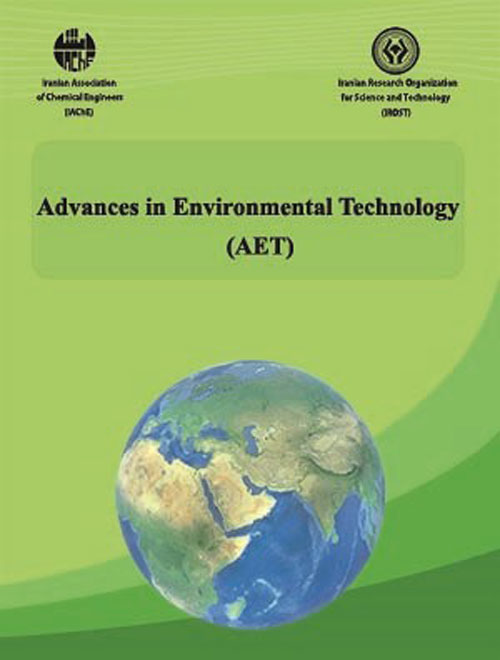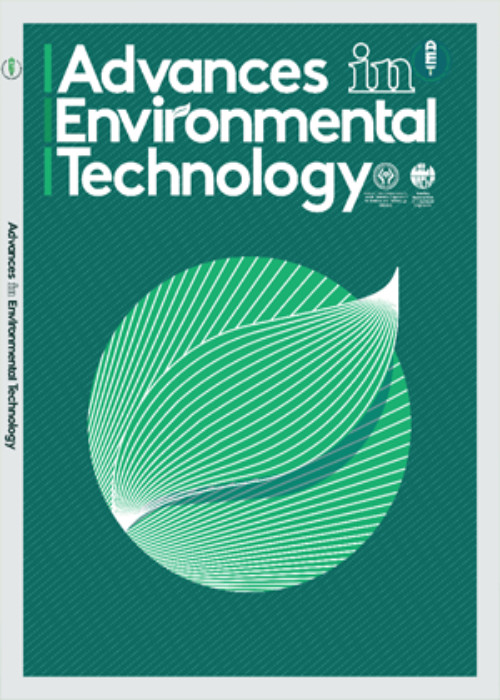فهرست مطالب

Advances in Environmental Technology
Volume:3 Issue: 1, Winter 2017
- تاریخ انتشار: 1395/12/02
- تعداد عناوین: 6
-
-
Pages 1-10The amount of pollutant gases in the atmosphere has reached a critical state due to an increase in industrial development and the rapid growth of automobile industries that use fossil fuels. The combustion of fossil fuels produces harmful gases such as carbon dioxide, nitrogen monoxide (NO), soot, particulate matter (PM), etc. The use of Dimethyl Ether (DME) biofuel in diesel engines or other combustion processes have been highly regarded by researchers. Studies show that the use of pure DME in automotive engines will be possible in the near future. The present work evaluated the environmental and performance effects of changing the injection strategy (time and temperature), piston bowl geometry, and exhaust gas recirculation (EGR) composition for a DME-burning engine. The modification of piston bowl parameters and engine simulation were numerically performed by using AVL fire CFD code. For model validation, the calculated mean pressure and rate of heat released (RHR) were compared to the experimental data and the results showed a good agreement (under a 70% load and 1200-rpm engine speed). It was found that retarding injection timing (reduction in in-cylinder temperature, consequently) caused a reduction in NO emissions and increased soot formation, reciprocally; this occurred because of a reduction in temperature and a lower soot oxidation in the combustion chamber. It became clear that 3 deg before top dead center (BTDC) was the appropriate injection timing for the DME-burning heavy duty diesel engine running under 1200 rpm. Also, the parametrical modification of the piston bowl geometry and the simultaneous decrease of Tm (piston bowl depth) and R3 (bowl inner radius) lengths were associated with lower exhaust NO emissions. For the perfect utilization of DME fuel in an HD diesel engine, the suggested proper lengths of Tm and R3 were 0.008 and 0.0079 m, respectively. Furthermore, various EGR compositions for the reduction of exhaust NO were investigated. The simulation results showed that a 0.2 EGR composition led to a reduction in the exhaust NO by 37%.Keywords: DME Fuel, HD diesel engine, EGR, piston bowl geometry, injection strategy
-
Pages 11-25Hazardous wastes include numerous kinds of discarded chemicals and other wastes generated from industrial, commercial, and institutional activities. These types of waste present immediate or long-term risks to humans, animals, plants, or the environment and therefore require special handling for safe disposal. Landfills that can accept hazardous wastes are excavated or engineered sites where these special types of waste can be disposed of securely. Since landfills are permanent sites, special attention must be afforded in selecting the location. This paper investigated the use of the Boolean theory and Fuzzy logic in combination with Analytic Hierarchy Process (AHP) methods by applying GIS and IDRISI software for the selection of a hazardous waste landfill site in the Iranian province of Hormozgan. The best location was determined via the Fuzzy and the Boolean methodologies. By collating the area selected for the hazardous waste landfill, this study found that Fuzzy logic with an AND operator had the best options for this purpose. In the end, the most suitable area for a hazardous waste landfill was about 1.6 km2 which was obtained by employing Fuzzy in combination with AHP and by using an AND operator. In addition, all the fundamental criteria affecting the landfill location were considered.Keywords: Hazardous waste, Landfill sitting, Analytic Hierarchy Process, Fuzzy logic, waste management
-
Pages 27-43Today, sustainable development is one of the important issues in regard to the economy of a country. This issue magnifies the necessity for increased scrutiny towards issues such as environmental considerations and product recovery in closed-loop supply chains (CLSCs). The most important motivational factors influencing research on these topics can be considered in two general groups: environment-friendly legal requirements and cost efficiencies. The most important elements in the closed-loop supply chain include collection centers and treatment centers. This paper intended to design a network according to the mentioned principles. In this regard, three types of product treatment centers were taken into account: physical, biological, and thermal. The network design was made via a new mixed multi-objective nonlinear mathematical model of integers. In this model, three objective functions were considered that included profit maximization, pollution minimization, and the minimization of the number of facilities under construction. The model was obtained after determining the number of collection and treatment centers, the number of containers for storage of different waste materials, the amount of waste sent from collection centers to the treatment centers, and the areas covered by collection centers. Due to the conflicting objective functions, a corrected NSGAII algorithm was used to solve this model. The change applied in the mentioned algorithm was made to determine the appropriate amount of the crossover percentage. The improvement in the performance of the proposed solution algorithm is shown using a numerical example. To prove the improved performance, a T-test was used to compare the means between the two populations. To select the optimum answer from the Pareto solution set, indices of D, S, and solution time were used and solved with TOPSIS.Keywords: network design, collection center, treatment center, modified NSGAII
-
Pages 45-51The chemical regeneration of granular activated carbon exhausted in a petrochemical wastewater unit was investigated. Gas chromatography and energy-dispersive X-ray spectroscopy demonstrated that spent activated carbon carries large types of organic and inorganic materials. Diverse chemical solvents were adopted in comparison with traditional chemical solvents and regeneration efficiency was investigated for each approach. The optimum procedure and optimum condition including temperature, concentration of solvent, and time were determined. The regenerated activated carbon was used in the adsorption of methylene blue (MB) in order to find its regeneration efficiency. The regeneration efficiency can be identified by comparing of amount of MB absorbed by the fresh and regenerated activated carbon. The best acidic regenerator was hydrofluoric acid. The higher the temperature causes the faster desorption rate and consequently, the higher regeneration efficiency. The regeneration efficiency increased by means of an increase in the time of regeneration and solvent concentration, but there was an optimum time and solvent concentration for regeneration. The optimum temperature, solvent concentration and regeneration time obtained was 80 ⁰C, 3 molar and 3 hours, respectively.Keywords: activated carbon, Chemical regenerator, Hydrofluoric acid, regeneration, waste water
-
Pages 53-58In this research study, methanol synthesis catalysts were manufactured with various mole ratios of metal carbonates (zinc, copper and aluminum carbonate) and ammonium hydrogen carbonate via a green solid-state method that employed a ball mill apparatus. Some parameters for the catalyst preparation, such as Al mole percent, Cu/Zn mole ratio, rotations milling speeds and aging time, were optimized to obtain the maximum catalyst activity. The prepared catalysts were compared with the best quality industrial catalyst under the same temperature and pressure condition in a titanium tabular fixed bed reactor. This novel method has many advantages in comparison to the conventional method. The main advantage of the solid-state method is that the methanol synthesis catalyst can be produced without using solvent. Furthermore, this new method reduces operating costs due to the elimination of the filtration and washing steps. Methanol synthesis catalytic activity was maximized at an optimized mole ratio of Cu/Zn of 1.9234 and an Al mole percent of 8 at the maximum grinding speed (450 rpm) during an aging time of 30 min, which showed higher activity (240 gCH3OH/kg cat.h) in comparison with an industrial catalyst sample (218 gCH3OH/kg cat.h). The production of a green catalyst, which requires less water and results in higher catalyst activity, can be widely used for methanol synthesis catalytic applications.Keywords: Solid-State method, Ball mill, Methanol, Green catalyst, environmental-friendly
-
Pages 59-65A new bimetallic nanocomposite of chitosan was prepared. Pd and Co nanoparticles were deposited on chitosan to produce a new heterogeneous recyclable catalyst for use in the bimetallic catalytic reduction reaction. The catalyst was characterized with common analysis methods for nanocomposites including Energy Dispersive X-Ray Spectroscopy, X-Ray Diffraction pattern, Thermal Gravimetric Analysis, Flame Atomic Absorption Spectroscopy and Scanning Electron Microscopy, and applied in the reduction reaction of nitroaromatics using NaBH4 at room temperature. The bimetallic system gave good results compared to each of the applied metals. Various aromatic amines and diamines were used in the reduction reaction. The aromatic amines were obtained as the sole product of the reduction reaction with 15 mol% Pd and 12 mol% Co during 2h. This reaction had some advantages such as mild reaction conditions, high yield, green solvent, and a recyclable catalyst. Also, the recovered catalyst was applicable in the reduction reaction without a significant decrease in the activity for up to six times.Keywords: Reduction, nitroaromatics, Chitosan, heterogeneous catalyst, bimetallic


